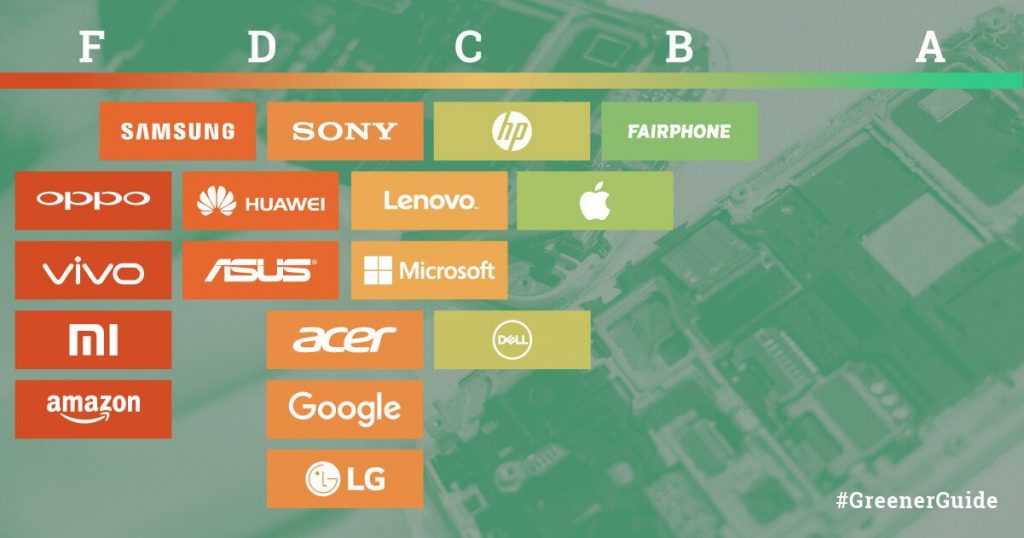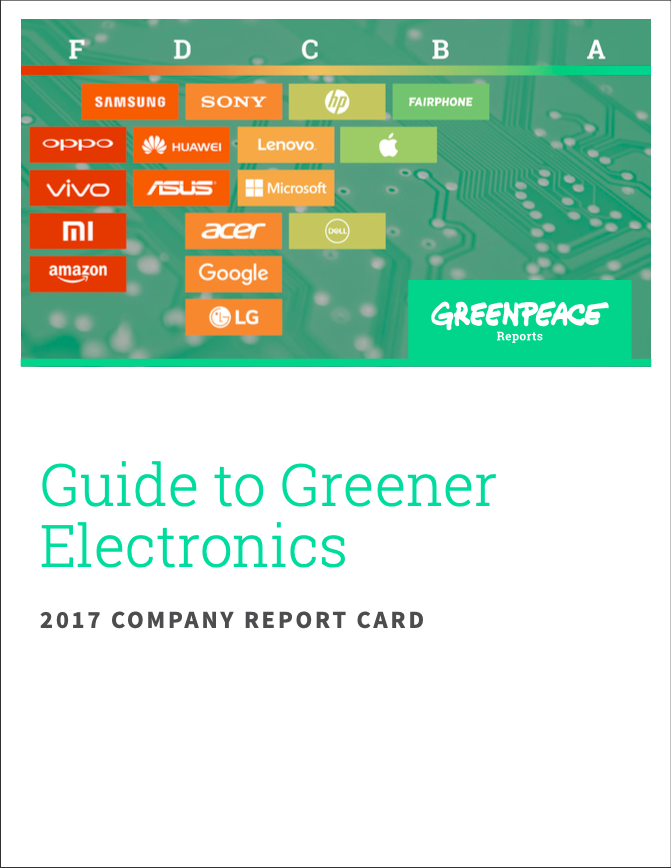The Guide to Greener Electronics is an analysis of what 17 of the world’s leading consumer electronics companies are doing to address their environmental impacts. Here’s how the companies stack up.

Executive Summary
There is no question that smartphones, PCs, and other computing devices have changed the world and our day-to-day lives in incredible ways. But behind this innovative 21st-century technology lie supply chain and manufacturing processes still reliant on 19th-century sources of energy, dangerous mining practices, hazardous chemicals, and poorly designed products that drive consumption of the Earth’s resources. This hidden reality stands in stark contrast to the forward-thinking, environmentally conscious image most IT companies project. Greenpeace launched the Rethink-IT campaign to challenge the IT sector to take responsibility for its rapidly growing footprint on the planet.
The Guide to Greener Electronics (the Guide, published by Greenpeace USA) provides an analysis of what 17 of the world’s leading consumer electronics companies are doing to address their environmental impacts, and where Greenpeace thinks work still needs to be done. From 2006 to 2012, Greenpeace published the Guide with regularity, and as a result saw steady progress from companies to eliminate hazardous materials from products and make them more energy-efficient. Now, it is clear the impacts of the linear take-make-waste business model employed by device manufacturers extend beyond the concerns of hazardous e-waste.
With the relaunch of the Guide, we have focused on measuring three critical impact areas tied to product design and responsible supply chain management across the electronics sector:
- Energy: Reduction of greenhouse gases through efficiency and renewable energy
- Resource Consumption: sustainable design and use of recycled materials
- Chemicals: Elimination of hazardous chemicals from both the product itself and manufacturing
Within each impact area, companies are graded on transparency, commitment, performance and advocacy efforts. In this edition of the Guide we have focused on the largest electronic device brands (smartphones, tablets, and personal computers) in East Asia, North America, and Europe.
Time to Re-Think IT
Billions of electronics are being made, sold, and disposed of every year—a cycle that drives short-term profits for electronics manufacturers, but at too high a cost for the planet we all share.
Mining for essential and finite raw materials often endangers workers and leaves the Earth irreversibly scarred. Coal-powered manufacturing contributes to rising global temperatures and the devastating impacts of climate change.
The companies that are designing and manufacturing our devices must take into account the significant impacts they are having on our planet and the increasing demand from the public to define innovation not by fewer millimetres and more megapixels, but by how they are made—with renewable energy, reusable materials, and long-lasting design.
Resolving the pollution problems created along the complex supply chain will not happen overnight, but it must begin at once. Fortunately, disrupting the status quo is nothing new to the IT sector. Now is the time for the tech sector to channel its expertise into reinventing the way that electronic devices are made and used in society, to reverse the ever-increasing consumption of the planet’s finite resources and reliance on fossil fuels, creating a circular and renewably powered business model that other sectors can follow.
Major Findings
- Lack of transparency in supply chain: Despite representing the majority of the environmental footprint for most electronic manufacturers, most companies publish little information on their suppliers, keeping their environmental performance and impacts hidden from view. Of the 17 companies evaluated, only six publish a basic list of suppliers and only Fairphone and Dell provide details on the products or services from each supplier. Among the top 3 brands in the global smartphone market, Huawei is the only brand reporting nothing about its supply chain greenhouse gas emissions.
- Supply chain driving demand for dirty energy: Upwards of 70 to 80% of the carbon footprint during the lifespan of personal computing devices occurs during manufacturing. Despite impressive progress a number of companies have made in starting the transition of their offices and data centres to renewable energy, nearly all of the companies have yet to address the rapidly growing carbon footprint and dependence on dirty energy in their supply chains. Apple is the only company thus far that has committed to 100% renewable power for its supply chain. Estimated GHG emissions (both own operations and supply chain) for the 17 companies in this guide were more than 103 million metric tons of Co2e in 2016, or roughly the same level emissions for the Czech Republic in one year.
- Samsung lagging on renewable energy: Samsung is both the largest manufacturer of smartphones worldwide and a supplier of key components to many of the other brands in the Guide, yet the company is holding the sector back by failing to tackle its climate change responsibility by committing to 100% renewable energy for its operations.The company used more than 16,000 GWh of energy in 2016, with just 1% coming from renewables.
- Smartphone brands from China gaining global market share, but losing in green commitment: Smartphone manufacturers from China, Huawei, Oppo and Xiaomi together occupied over a quarter of the global smartphone market share in quarter two of 2017[1]. However, they score below average in all three impact areas, especially lacking transparency and substantial commitment in renewable energy. Huawei, now one of the top 3 smartphone brands in the world, has yet to realise its tremendous potential in environmental leadership.
- Amazon remains one of the least transparent: Amazon remains one of the least transparent companies in the world in terms of its environmental performance, as it still refuses to report the greenhouse gas footprint of its own operations. While Amazon is willing to talk about its recent renewable energy deals, the company provides few details on its sourcing of recycled materials that are going into its devices, nor does it publish any restrictions on hazardous chemicals in its devices or being used in its supply chain as other leading electronics brands provide.
- Planned obsolescence as design feature: Faced with market saturation for their devices in many countries, companies across the sector have increasingly changed the design of their products in a way that accelerates the replacement cycle by, making them difficult to service or upgrade, shortening the useful life of otherwise functional devices. Apple, Microsoft, and Samsung are among the companies moving in the wrong direction on sustainable product design. HP, Dell, and Fairphone are the notable exceptions to this trend, producing a growing number of products that are repairable and upgradable.
- Lack of urgency, transparency in tackling global e-waste problem: Worldwide e-waste volumes are expected to surpass 65 million metric tons in 2017[2]. While a number of brands now offer some voluntary take-back programs, there is little if any reporting on what is actually being collected or where it goes upon collection. The end result: less than 16% of global e-waste volumes are estimated to be recycled in the formal sector,[3] despite the valuable materials contained within. Often “recycled” e-waste ends up at informal recyclers and handled in ways that endanger worker health and the local environment.[4]
- Use of secondary materials remains limited, with some recent progress: While a few IT companies have incorporated recycled plastics in their products for several years, very little progress has been made in sourcing other secondary materials into new products. Fairphone incorporates recycled tungsten, and Dell has shown success in using closed-loop plastic collected from its take-back channel. Apple recently committed to “closing the loop” for its materials, starting with tin and aluminium.
- Stalled commitments to product detox: Numerous companies, including Acer, Apple, Samsung, LG, Lenovo, Dell and HP made commitments in 2009/2010 to phase out PVC and BFRs from their products, to stem the tide of toxic e-waste. Now in 2017, only Apple and Google products are free of BFR and PVC across their product lines.
- Lack of transparency and monitoring of workplace chemicals: To eliminate hazardous releases to the environment from manufacturing facilities and also to protect worker health and safety, all companies in the Guide have work to do to identify and eliminate hazardous chemicals used in the production of their products, improve worker health and safety due diligence, and develop safe substitutions. Apple, Dell, Google, HP and Microsoft are the only companies in the Guide that publish their list of substances that must be restricted in the manufacturing of their devices (MRSL).

